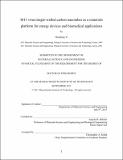M13 virus/single-walled carbon nanotubes as a materials platform for energy devices and biomedical applications
Author(s)
Yi, Hyunjung
DownloadFull printable version (31.94Mb)
Other Contributors
Massachusetts Institute of Technology. Dept. of Materials Science and Engineering.
Advisor
Angela M. Belcher.
Terms of use
Metadata
Show full item recordAbstract
Making nanocomposites from combinations of materials each with their own unique functional advantage can often solve issues that cannot be addressed when utilizing only one type of materials. Therefore, controlling nanosturucture and nanoarchitecture have become central issues in both high performance energy devices and nanobiomedical applications. Biological systems can provide precise control over materials interaction between peptides and other non-biological materials through biological molecular recognition, and the capability of modifying and controlling materials interaction through genetic engineering provides an attractive route to creating new nano-structured hybrid materials systems. In this thesis work, new approaches to effectively incorporate single-walled carbon nanotubes (SWNTs) into energy devices are presented. Genetically engineered M13 virus clones are developed to assemble SWNTs and technically important inorganic materials biomineralized on the protein surfaces of M13 virus to create hybrid nano-structured electrodes for high power Li+ ion batteries and highly efficient photovoltaic devices. Moreover, new imaging probes for molecularly targeted fluorescence imaging of tumors are developed by utilizing the highly bright and water-stable SWNTs and genetically modifiable M13 virus. The fundamental understanding and new approaches this work presents will provide new insight into designing materials for high performance energy devices and nanobiomedical applications.
Description
Thesis (Ph. D.)--Massachusetts Institute of Technology, Dept. of Materials Science and Engineering, 2011. This electronic version was submitted by the student author. The certified thesis is available in the Institute Archives and Special Collections. Cataloged from PDF version of thesis. Vita. Includes bibliographical references.
Date issued
2011Department
Massachusetts Institute of Technology. Department of Materials Science and EngineeringPublisher
Massachusetts Institute of Technology
Keywords
Materials Science and Engineering.